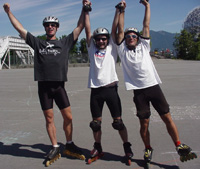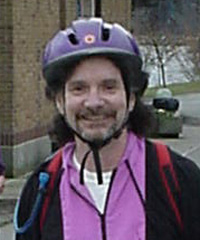Inline speed skating, 101 |
|
 By Jim
Fink By Jim
FinkFeb 28, 2001 Special thanks to Ken Russell, Seattle, WA and Sam Weaver, Oakland, CA
(left to right Sam, Jim and Eddy) |
|
First,
a disclaimer. I am not a speed skater per se. I know and have seen real, competing speed
skaters and I know solidly I am not one of them—yet.
I also might point out that the date of this article marks exactly my second
year on inline skates, so the wheeled world is still in front of me. However, by this time
I have found myself between the recreational skaters and the speed demons—I guess I
can feel a bit proud. Between ski trips, I spent this past winter indoors and found myself
getting involved with the indoor speed group. And what a world it is. The first word that
came to my mind was “humbling.” The second word I came to respect was
“workout.” As competition racing is not a real-life goal for me at this time, I
must, however, agree with master skater Sam Weaver when he says, “For me, the
‘fun’ is derived from the ‘competition’ with myself. If I can do one more interval or “one
more” anything, it’s a blast!” I came to open my mind to a
different type of skating exercise, a genuine workout in a regimented and specialized
setting. To many “outsiders,” skating around in a circle (turning
left all the time) can be perceived as quite tedious and roughly pointless. I can
understand that viewpoint because I was there as an “outside” skater. But, if
the indoor track is well coached, that circle turns into a ring of truth and growth. There
are several characteristics to indoor speed skating that any intermediate skater can take
advantage of. Drills. The drills make the skating experience more intense
and concentrated (doing more with less). They are planned to bring a skater up from the
beginning to advanced at your own speed and some even bring their heart rate devices to
log their personal growth rate (pretty cool gadgets). Most of the drills are not about
speed, oddly enough, but more about completing them to improve your endurance and to get
in touch with your own strengths and weaknesses. It’s one of the best environments to
push your limits. Figure eights, passing, relay races (disguising what is really effective
training), pack skating and intermittently even going the other direction, are some
samples. I found it very reassuring that I was able to drop out of any drill at any time
without condemnation from the other skaters, which made me feel still valued. So, only after three sessions I found that my
“outdoor” skills had improved. I sure felt more focused and sleek! I
skate now with much more confidence and people do notice. Other skaters. This had to be one of the most potent and
subliminal features. Skating with better skaters always makes you a better skater. You can
see first-hand what they are doing, talk to them, and try to keep up when you can. I am
always in awe of a well-practiced speed skater and will study his or her style and
technique from behind (they are always in front of me) or from the bench. They will all
give you tips to help connect the flow. An excellent mental image is real important for
your own development and the speed rink is the place to get it. Don’t be afraid to
mimic an advanced speeder, you might find a new level in your skating. However, and I must
add this, the young speeders (I mean teens and under twenty five) are especially fast and
amazing to watch. But, they still live in that bewildering hormone/ego zone, so one needs
to temper one’s point of view and expectations when skating with that age
group—but good tips can still be sifted out. Remember, there will always be someone
faster, stronger and better than you because many of these skaters have been skating
indoors before inlines where used. Henceforth,
getting lapped is part of the game! Keep smiling! Don’t let it get you down! The workout. Yes, it is a workout. Dripping wet, soggy tee
shirts. How is it that I can skate 20 or more miles on an open trail, but have a difficult
time finishing 30 laps indoors? Simple. No coasting! Corner technique and sprinting.
Constant pushing around the turns and getting exposed to cornering in a crowd keeps you
always moving. Always working to make those crossovers powerful. The strongest skaters
come from the indoors and its no wonder. I have seen beginning speeders go from not being
able to crossover, to getting it in less than a month. Sprinting. Running on your skates
is a real energy burner. Getting low and staying low is key for those long leg extensions
for optimum power. It is a fabulous workout
just going around the ring of truth as low as you can go. As you begin to work on your
crossovers and sprints, your muscles rebel and the lactic acid begins to pile up, you know
you are working your body. Hey, its only training practice, so feel free to pull over for
some water. Keep showing up for practice and you’ll keep pushing back those
thresholds. At the end of each session, you’ll be tired, a little faster and a little
better skater. An excellent way to keep fit for the ensuing spring and summer months
ahead. Falling. Everyone’s favorite fear. Yes, I have crashed, a
few times. I suffered bruises mainly, but more often a burn from skidding on the floor.
The very fast skaters sometimes even endure a broken bone. (Personally I’d rather
fall indoors than outdoors—indoors is smooth, outdoors is reminiscent of hugging a
belt sander.) Is it safer than outdoors? As we all know, skating is a risk at anytime and
crash management is part of skating. Some speeders wear minimal pads, others only a helmet
and skin suit and take what comes. But yes, crashing is part of any sport and indoors
speed skating has its share. A sarcastic friend once told me that “if you want a
guarantee, buy an appliance.” I knew what he meant, kind of a “tough love”
response. Pack awareness. The most fearful element for me was getting
used to pack skating. I skate 99 percent of the time by myself (time restraints more than
anything else) so pack skating for me was entering the Twilight Zone. Getting THAT close
to another skater was challenging. First, it really limits your visibility so you must
trust the skaters in front of you. There is also the fear of catching another
skater’s frame or possibly a pylon, but the more you do it the more second nature it
becomes. Granted it took a while before feeling at ease in a pack, but when you are
skating with good skaters, pack skating becomes more controlled. Drafting, passing and
changing the lead all take on a unique personality in a pack. Getting in synchronicity
with the other skaters forces you to become a better skater, something unattainable on
your own. Soon, touching and being touched feels supportive when you are whizzing around
the track. Practice slowly with friends, you’ll be surprised at how close you can
get. Equipment. Perhaps the most sought after Holy Grail. When a skater begins to dedicate oneself to a chosen sport, the equipment gets expensive. Showing up at speed practice with your recreational skates isn’t a no-no, and may be a way to try it out without the financial investment. However, it is very inspiring and one becomes more competent if one has the proper speed gear, but that can come later. Most, if not all speeders use five wheel frames, but I have run across speeders that use a long four-wheel configuration. Some folks use their quad skates and that is okay, but it is hard to hang on in the corners unless you use special speed wheels—even then quads aren’t as fast as low cut inline speed skates. If you find that running with the speed skaters is where you want to be, speed skates will be a necessary investment. So getting into your local indoor track, most all will have the low cuff, five wheel roller boots but don’t let that bother you—you’re there to snoop. Showing up with your recreational boots is the great way to get your feet wet to see if you enjoy the sport or not—a smart move I think. I enjoyed my indoor experiences and will strive to continue to make
it part of my overall skating experience in the years ahead—at least that’s my
intention. I found many of my limitations and have conquered some of my fears making
indoor speed skating a very nice compliment to my “outdoor” skills. The indoor
world is different than the outdoor world, but a good number of the skaters I know
are skilled at both and I’m glad I can now be counted among them. See you at the rink. |
|
